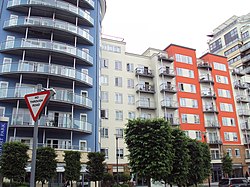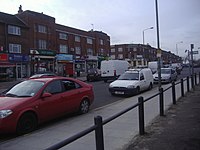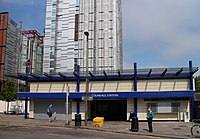Colindale
| Colindale | |
| Middlesex | |
|---|---|
 Beaufort Park in Colindale | |
| Location | |
| Grid reference: | TQ213897 |
| Location: | 51°35’35"N, 0°14’52"W |
| Data | |
| Population: | 17,098 (2011) |
| Post town: | London |
| Postcode: | NW9 |
| Dialling code: | 020 |
| Local Government | |
| Council: | Barnet, Brent |
| Parliamentary constituency: |
Hendon |
Colindale is an urban area in ththe north-west of Middlesex, along the A5 Edgware Road (the old Roman Watling Street). This is an area of suburban character, and in recent years has emerged as a hotspot for new build apartments amid a large regeneration scheme.[1][2] It is to be found to the south of Edgware and east of Queensbury.
History
Formerly in the Parish of Hendon, the area was essentially the dale between Mill Hill and [[The Burroughs. By the middle of the 20th century, it had come to include that part of the Edgware Road between The Hyde and Burnt Oak.
The area is named after a 16th-century family of the same name. Until the 20th century, Colindale was without any buildings save for a large house called Colindale Lodge, Colindale Farm and a few cottages. A spelling with two Ls, 'Collindale', has been used. All of these properties were on Colindeep Lane which had in the mediæval period been an alternative route out of London (via Hampstead, Golders Green and Hendon) to the Edgware Road. By the end of the 16th century it was not often used as a main road and by the middle part of the 19th century was called Ancient Street.
By the end of the 19th century, cheap land prices made Colindale attractive to developers. Colindale Hospital was opened in 1898 as an asylum for the long-term sick of central London, and in 1907 The Government Lymph Establishment for making vaccines was built. By 1996 the majority of the hospital was closed, and by 2009 was mostly derelict.[3] The site is now a housing development, consisting primarily of apartment blocks.
In 1902, the British Library built a new depository for newspapers and periodicals on Colindale Avenue. Initially, material was merely stored at Colindale and transported into central London for consultation. However, the newspaper library reading room moved to Colindale in 1934.
Hendon Tram Depot (site now occupied by Merit House, opposite Oriental City) was in 1910 the scene of the first trials in Britain of a trolleybus. This location eventually became Colindale Trolleybus Depot, from which route 645 operated until January 1962, when the depot was closed down and eventually demolished. Land behind the depot was used from 1959 to 1962 by the George Cohen 600 Group for scrapping the vast majority of London's fleet of 1891 trolleybuses.
Manufacturing
Garston's Ltd established a trunk factory in 1901, as well as a row of cottages called Leatherville. As such it is the first manufacturer 'in the Colindale'. By 1914 there was already housing between Colindale Avenue and Annesley Avenue, mostly to house the workers of such endeavours.
During the First World War Colindale became an important centre of aircraft production. The Airco factory was, at the time, the largest aircraft manufacturing company in the world.[4]
Immediately after the First World War demand for aircraft declined, but a number of other manufacturing companies came to Colindale. General Motors took over some of the Airco buildings.[5] Franco Illuminated Signs opened on Aerodrome Road in 1922, having made the lights for the Franco British Exhibition of 1908 (it was later abbreviated to 'Franco'). It was best known for the neon signs found in Piccadilly from the 1920s to the 1970s. Frigidaire started in a wooden shack in Aerodrome Road, employing 11 people in 1923, and selling the first automatic household fridges in England.
The reason why many of these and other companies chose Colindale was that there was land available for expansion. However, by 1923, when the tube railway reached Colindale, land prices had increased and factory expansion was not so easy, so some industries looked elsewhere for premises. In 1931, Frigidaire, for example, decided to build a new manufacturing plant to the west, on the Edgware Road, and had moved its entire operations there by 1946.
Suburban expansion
After the tube station opened, development as a suburb was rapid, and by 1939 much of the western side was semi-detached housing. Typical was the Colin Park Estate, built by F. H. Stucke & Co. around Colindeep Lane in 1927. Some of the houses on this estate are by the architect E. G. Trobridge.
St Matthias started as a mission church in 1905. Its permanent building was opened in 1934, and rebuilt between 1971 and 1973. Colindale Primary School opened in Colindeep Lane in 1921, with a new building constructed in Woodfield Avenue in 1933. In 2011 the design and build for a new three form entry school was completed by The Kier Group and Sprunt Architects.
Today
Colindale houses many of North London's largest institutions, including the Royal Air Force Museum, Public Health England's Centre for Infections, the Colindale Campus of Barnet and Southgate College (opened August 2016) and the Peel Centre (better known as Hendon Police College).
The British Library's newspaper depository was also in Colindale until it was closed in 2013 (to be replaced by a new depository in Boston Spa, Yorkshire, in 2015).
Also located here is the Grahame Park Estate, built on the former Hendon Aerodrome.
Outside links
| ("Wikimedia Commons" has material about Colindale) |
References
- ↑ David Spittles. "Colindale emerges as a new Zone 4 property hotspot for first-time buyers: former Met police academy in Hendon has been transformed into new homes". Homes and Property. https://www.homesandproperty.co.uk/property-news/buying/new-homes/the-1m-colindale-gardens-project-former-met-police-academy-transformed-into-new-homes-a100881.html. Retrieved 2020-04-27.
- ↑ "Regenerating Colindale | Galliard Homes". https://www.galliardhomes.com/investor-information/investor-guides/guide/regenerating-colindale.
- ↑ "Hospitals". Derelict London. http://www.derelictlondon.com/hospitals.html.
- ↑ "Colindale (Hendon NW9)". http://www.barnet.gov.uk/libraries-old/local-studies-and-archives/pocket-histories/hendon/colindale-hendon-nw9.
- ↑ Last, Londonist (2016-10-06). "London's Lost Manufacturing: We Were Once The British Detroit". Londonist. https://londonist.com/2015/11/london-made-motors. Retrieved 2020-04-27.

